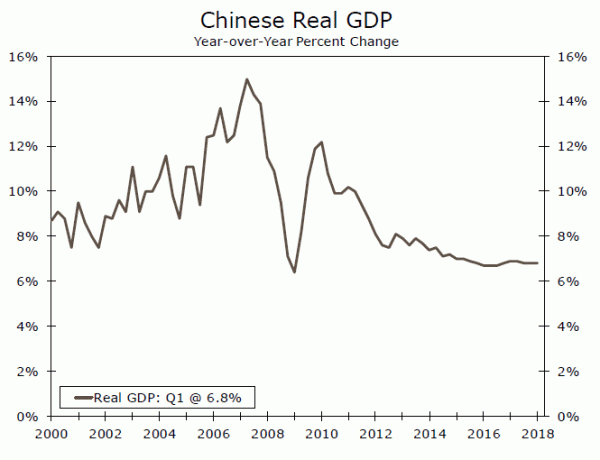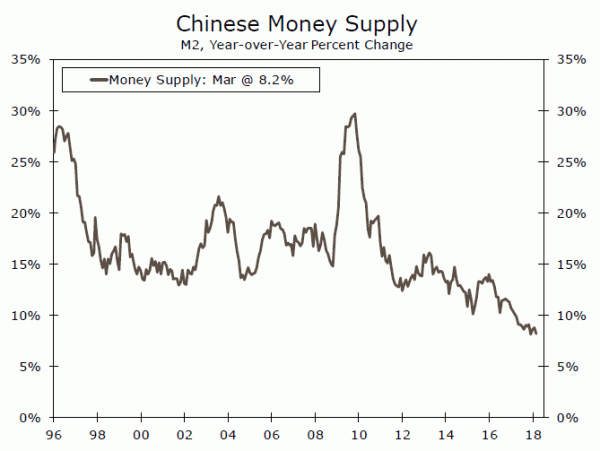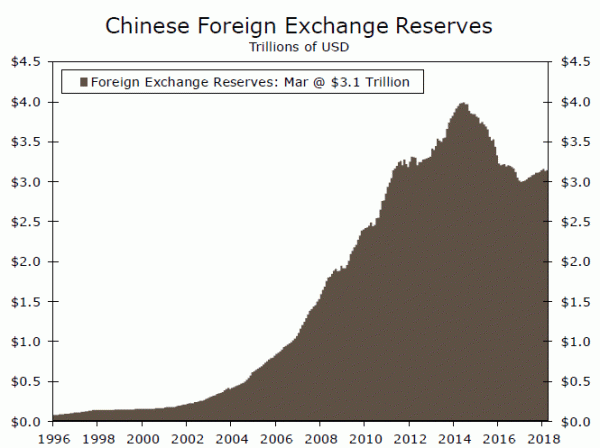Real GDP growth in China was 6.8 percent year over year in Q1, the third consecutive print of this magnitude. Decelerating investment spending presages a gradual slowdown in economic growth in the coming quarters.
Chinese Growth Continues to Hold Firm
Real GDP growth in China met expectations for Q1-2018, matching the Bloomberg consensus forecast of 6.8 percent year over year. Economic growth in China has been remarkably stable over the past couple of years as policymakers have worked to engineer a “soft landing” as the economy enters a more mature phase of its development (top chart). Retail sales growth rebounded strongly in Q1 after hitting a mild soft patch to end Q4-2017. In the press release from the National Bureau of Statistics of China, the agency noted an acceleration in services output in March, suggesting solid momentum heading into Q2. However, investment spending and industrial production both decelerated in March. In part, this reflects a conscious effort by Chinese policymakers to shift the economy towards a more consumptionoriented model of growth. Trade also likely contributed to growth in Q1. Data through February showed robust export volumes, with year-over-year growth of 17.1 percent on a three-month moving average basis.
On balance, today’s report reaffirms our outlook for the Chinese economy. Economic growth remains firm, boosted by the cyclical-upturn in the global economy. However, we believe structural factors will continue to weigh on economic growth over time. Decelerating investment spending and an aging population are the ingredients for slowing potential growth. In addition, Chinese policymakers recognize the possible threat from high leverage in the nonfinancial corporate sector and have taken steps to slow credit growth. Money supply growth as measured by M2 continues to slow (middle chart). These factors underpin our forecast for economic growth in China to slow gradually over the remainder of this year and next.
China a Treasury Buyer Before Trade Troubles
In a report released yesterday, data on international capital flows showed net purchases of U.S. Treasury securities by foreign investors increased in February by the most in nearly a year. Both private and public institutions were net buyers, and foreign official buying returned in force, rising $19.1 billion, the most since June 2014. Treasury does not provide a private/official breakdown for individual countries, but as a whole Chinese buyers saw a sizable increase in the month, up $8.5 billion on net.
China is the largest foreign holder of U.S. Treasury securities, with about $1.2 trillion in holdings (or about 8 percent of U.S. debt held by the public). On the public side, China holds U.S. Treasury securities largely to back its sizable war chest of FX reserves (bottom chart). In our view, it seems unlikely the rising trade tensions between China and the United States have materially impacted China’s Treasury buying thus far. That said, what is debt to one person is an asset to another, and China’s considerable Treasury asset holdings represent yet another way in which the fortunes of these two economic powerhouses are intertwined.
















